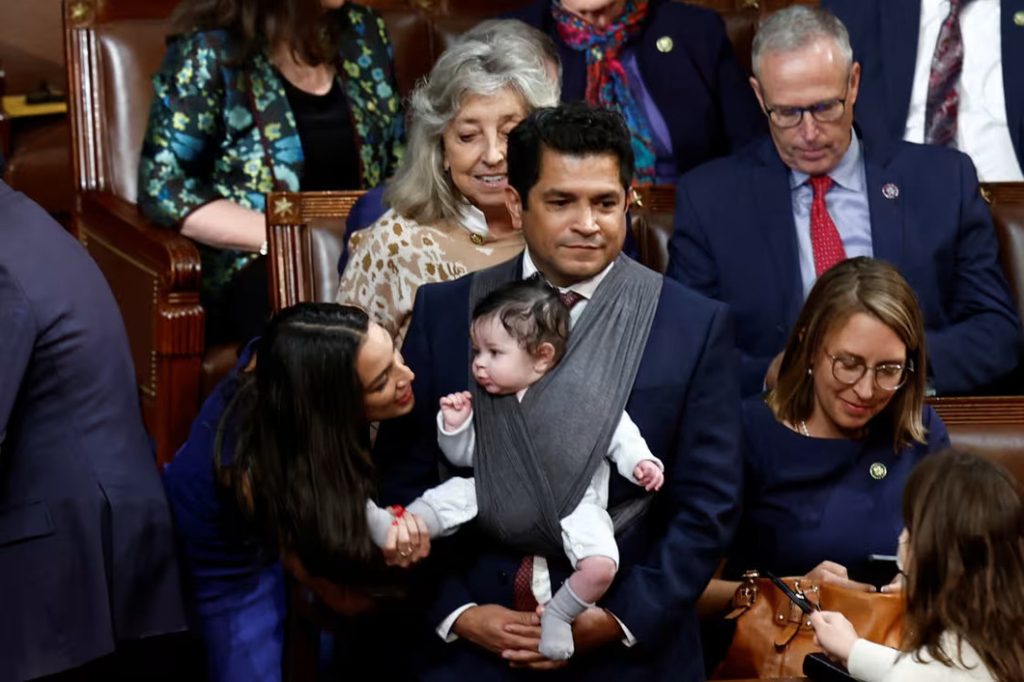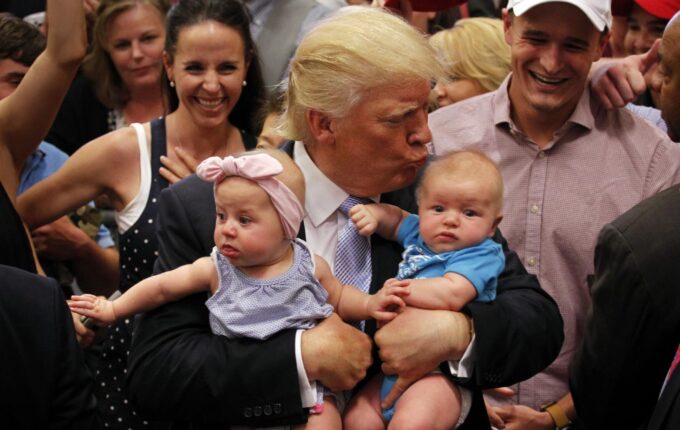Trump’s Push to Boost Birth Rates Faces Criticism Over Policy Gaps
Former President Donald Trump’s team is exploring strategies to increase the U.S. birth rate, with Trump himself stating he’d welcome the nickname “the fertilization president.” However, Democratic lawmakers and family policy advocates argue that such efforts fall short of addressing the real economic pressures families face.
“Encouraging families to have children requires more than slogans — it demands real investment in lowering costs and building financial stability,” said Rep. Rosa DeLauro, a long-serving Democrat from Connecticut and a vocal supporter of a national paid family leave program.
Since 2007, U.S. fertility rates have steadily declined, hitting a record low in 2023 before leveling off the following year, according to the Centers for Disease Control and Prevention. This trend reflects a global decline in birth rates, not just a domestic phenomenon.
In April, The New York Times reported that proposals under review by the Trump administration to boost births include a $5,000 cash bonus for new mothers and government-sponsored education on menstrual cycles. Transportation Secretary Sean Duffy reportedly instructed his department to prioritize funding for communities with higher rates of marriage and childbirth.
A senior White House official confirmed to NBC News that increasing the birth rate remains a goal, saying, “That’s what we talked about during the campaign.” When asked about the proposed baby bonus during a White House event, Trump said it “sounds like a good idea to me.”
Rep. Chrissy Houlahan, a Democrat and co-chair of the bipartisan House Paid Family Leave Working Group, criticized the approach, calling it “laughable if it wasn’t so sad.”
Rep. Jimmy Gomez, who leads the congressional Dads Caucus, said expanding the Child Tax Credit would be a far more effective and lasting solution than a one-time cash incentive.
“Raising kids isn’t a one-off expense — it’s a monthly challenge,” Gomez said. “If the Child Tax Credit were paid out monthly, it would make a real difference for families.”
Gomez cited data showing that in 2024, renters spent 31% of their income on housing, while homeowners spent 21%. At the same time, families dedicated nearly 30% of their savings to child care expenses, according to a Care.com report.
Yet the $2,000 annual Child Tax Credit enacted under Trump’s 2017 tax law is set to shrink to $1,000 at year’s end unless extended.
In response, Senate Democrats proposed expanding the credit to $6,360 for newborns, gradually reducing it to $3,600 for children aged 6 to 17. But with Republicans holding congressional control, the bill faces steep opposition — although some GOP lawmakers have expressed interest in alternative increases to the credit as part of a broader tax reform package.
“I’m not convinced the Trump administration is genuinely committed to real solutions,” Gomez said. “These ideas have been on the table for years. If they were serious, they’d act on them.”
Erin Erenberg, CEO and co-founder of Chamber of Mothers, a bipartisan organization supporting parental rights, said the issue is rooted in affordability, not culture.
“Women aren’t avoiding motherhood because of changing values — they simply can’t afford it,” Erenberg said. “This isn’t a cultural problem. It’s a failure of policy. We don’t need incentives for parenthood — we need support.”
Her group advocates for three core federal policies: paid family leave, maternal health investments, and accessible, affordable child care.

White House Press Secretary Karoline Leavitt defended former President Trump’s approach to supporting families, stating, “President Trump is proudly implementing policies to uplift American families—from securing our borders to keep violent criminals out of our communities, to lowering taxes and the cost of living.”
However, Democrats argue that many of Trump’s policy proposals contradict his stated desire to promote family growth. Rep. Rosa DeLauro of Connecticut questioned the administration’s sincerity in encouraging women to have more children, pointing to Republican efforts to push legislation that would slash funding from programs critical to low-income families.
“If the goal is truly to support families and encourage childbirth, then you have to look at the broader policy picture,” DeLauro said. She cited a proposed reconciliation bill backed by House Republicans that could strip $880 billion from Medicaid, which provides healthcare for millions of low-income families and children. “There’s a real contradiction between saying you want families to grow while erecting massive barriers to their financial stability.”
Rep. Jimmy Gomez of California raised similar concerns, particularly about Trump’s plan to impose tariffs on imported goods—many of which are essential for young children.
“My son burns through shoes faster than I can count. And that’s not unique to him — that’s every toddler,” Gomez said. “From ages one to five, a child typically goes through 16 pairs of shoes, costing anywhere from $15 to $60 each. And 99% of the shoes sold in the U.S. are made overseas.”
He added that nearly all baby essentials—cribs, car seats, strollers—are also imported. “So how does making those more expensive help families?”
In a recent interview on NBC’s Meet the Press, Trump was asked about how tariffs might increase costs on children’s products. He responded, “They don’t need to have 30 dolls. They can have three. They don’t need to have 250 pencils. They can have five.” When pressed about rising prices on items like strollers, Trump downplayed the issue, saying, “Gasoline is going down. Gasoline is thousands of times more important than a stroller.”
Trump has also promoted an executive order signed in February aimed at expanding access to in vitro fertilization (IVF). At a Women’s History Month event, he credited Sen. Katie Britt (R-Ala.) with raising the issue and said, “I’ll be known as the fertilization president, and that’s OK.”
Yet critics note that the executive order did not enact any new policies, and it fell short of his campaign promise to have IVF either funded by the government or mandated for insurance coverage. In fact, the administration has made cuts to federal fertility programs. A CDC team that tracked IVF success rates nationwide was dismantled last month amid broader budget reductions.
Health advocates also point out that childbirth remains risky in the United States. The CDC reports that the U.S. maternal mortality rate is 18.6 deaths per 100,000 live births—one of the highest among wealthy nations. Infant mortality is also climbing. Despite this, the administration cut funding to the country’s largest women’s health research initiative.
Rep. Chrissy Houlahan of Pennsylvania argued that these cuts run directly counter to the administration’s stated family goals.
“What really matters is what’s being quietly stripped away at the same time these flashy proposals are being made,” Houlahan said. “We’re seeing cuts to maternal and child health programs, threats to Head Start, and attempts to slash Medicaid—which covers 40% of all births in the U.S.”
She called the idea of a one-time $5,000 baby bonus insufficient and misleading. “It’s meaningless if you’re dismantling the entire support system that would allow a family to raise that child,” she said. “It’s just completely bananas.”

